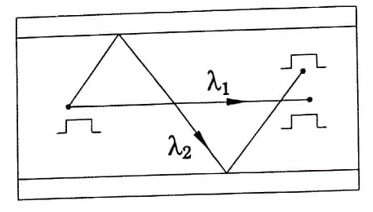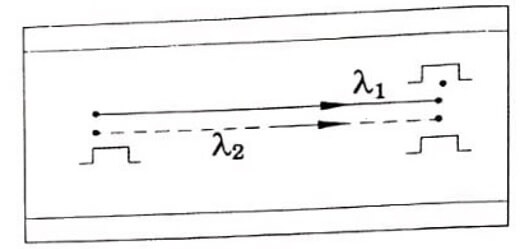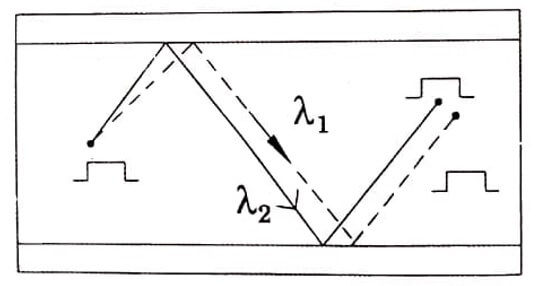When light propagates through an optical fibre, a small percentage of light is lost through different mechanisms. This loss of optical energy during the transmission is known as transmission loss.
Hence the two factors which affect the transmission of light waves in optical fibres are
i. Attenuation
ii. Dispersion
Attenuation
The loss of optical power as light travels down a fibre is known as attenuation. It is also defined as the ratio of the optical power output (Pout) from a fibre of length ” L ” to the power input. (Pin ).
Attenuation ![]()
There are three mechanisms that can be attributed to attenuation.
- Absorption losses
- Scattering losses
- Radiation or bending losses.
(1) Absorption Losses : The loss of optical energy due to the absorption of light by the optical fibre is known as absorption losses. It is divided into three types:
The absorption of optical energy by the basic atoms present in the optical fiber is known as intrinsic absorption. This absorption cannot be avoided.
The optical fiber may have defects such as vacancies and dislocations. These vacancies and dislocation may absorb the optical energy.
c) Extrinsic absorption
The optical fiber may have some other foreign elements like Fe, Ni, and Cu etc. These impurities absorb the optical energy. This absorption is known as extrinsic absorption.
(2) Scattering Losses : The loss of optical energy due to scattering of light is called scattering losses. It is mainly divided in to two types.
a. Linear scattering losses and
b. Non-linear scattering losses.
(a) Linear scattering losses: The losses of optical energy due to scattering of light from one propagating mode to a different mode are called liner scattering losses.
The linear scattering loss is also sub divided in to two types they are given below.
(i) Mie scattering : These are linear scattering due to the variation is structural in homogeneities of the optical fibre. The optical energy propagating through the optical fibre is scattered out by the variations in size and shape of the optical fibre.
(ii) Rayleigh’s scattering : These are linear scattering losses due to the microscopic variation in material density. A light variation in the refractive index causes the scattering of light.
(b) Non – linear scattering losses: The losses of optical energy from one mode to other mode (direction) with a different frequency are known as Non-linear scattering.
So, a frequency shift of the scattered light is made and the light moves inside the fibre either in forward or backward direction. This non-linear scattering is also sub-divided in to two types.
(i) Brillowin scattering: Here, the incident photon produces a scattering photon with a photon of acoustic frequency.
(ii) Raman’s scattering: Here, the incident photon produces a scattering photon with a photon of high frequency.
(3) Radiation or bending losses: This is the loss of energy due to the geometry of the optical fibre. Optical energy is wasted due to the variation in size, shape and uniformity of the optical fibre. They are subdivided in to two types.
a) Micro Bending losses: The bending losses in optical fibre when the radius of the bending is small with respect to the fibre diameter.
b) Macro bending losses: The bending losses in optical fibres when the radius of the bending is larger with respect to the fibre diameter.
Dispersion losses
When an optical signal (or) pulse is sent into the fibre the pulse spreads (or) broaden as it propagates through the fibre. This phenomenon is called dispersion.
The dispersion losses are of three types, namely,
i. Modal dispersion
ii. Material dispersion and
iii. Wave guide dispersion
i. Modal dispersion
Modal dispersion occurs in fibres that have more than one mode of propagation.

When light ray travels through the fibre with all possible modes differing in the path line (i.e) some rays will reach the core end before the another. The information transmitted is stretched out. If the pulse stretch is much, they begin to overlap with each other and may reach a point with a time difference.
ii. Materlal dispersion
Material dispersion occurs due to the variation of refractive index of the material and wavelength of the light used.

The change in signal is due to the fact that different wavelengths travel at different speeds. Which in turn depends upon the refractive index of the material through which the light is transmitted.
iii. Wave gulde dispersion
Wave guide dispersion occurs only in the fibres with single mode.

The wave guide dispersion arises due to the guiding property of the fibre and due to their different angles at which they incident at the core-cladding interface of the fibre.
Among the three dispersions
Intermodal dispersion > Material dispersion > Wave guide dispersion.
| Read More Topics |
| Types of semiconductor laser |
| Ultrasonic testing methods |
| Neodymium doped yttrium aluminium garnet |





